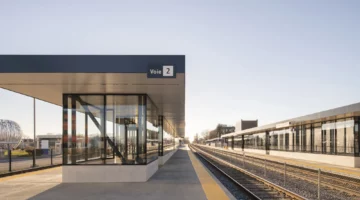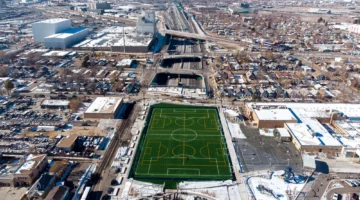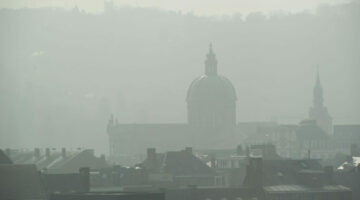"A mirror-polished silver box stands proudly on a corner of the Greenwich Peninsula, reflecting a curious new world of architectural experiments. To one side wriggles a transparent caterpillar of a building, with clear plastic stretched around a bright yellow frame, forming a space-age chrysalis. Next door stands a veiled stack of raw concrete floors, the bare bones of a building draped with a ghostly shroud of steel netting, giving it the look of a multistorey aviary. Nearby there is a sturdy, low-slung box covered in rusty panels of Cor-ten steel, and a little tower-like block wrapped in a corduroy cloak of slender white tubes. Elsewhere in the menagerie we find a pair of triangular wedges dressed in harlequin costumes of pink and green terrazzo diamonds, and several other creatures whose exotic plumage has yet to emerge from behind the scaffolding.
This gaudy eyeful is the new Design District, a planned “creative quarter” at the heart of the Greenwich Peninsula in London. Opening in phases over the coming months, it is intended to provide affordable workspace for around 1,800 people across the fields of fashion, food, tech, craft and more. With eight architects each charged with designing a pair of buildings, it is an eclectic zoo of structures, the self-consciously funky vibe intended to lure creative types across the river from Shoreditch – along with the £5/sq ft rents for the first year (not including the costly service charge).
The Design District is the brainchild of image-conscious developer Knight Dragon, a company backed by Hong Kong billionaire Henry Cheng Kar-shun, which has been leading the £8.4bn development of the peninsula since 2012. It is touted as one of the biggest regeneration projects in Europe, with 17,500 homes and 70,000 square metres of office space across the 80-hectare site, and towers of up to 36 storeys, realising the Millennium project around the former Dome, more than 20 years on.
So far, a history of different masterplans has created a disjointed place where grim glass cliffs of investment flats march down one edge of the peninsula, forming a defensive battery alongside the dome – now the O2 – separated by a gulf of car parks from the more affordable housing at the other end of the site. Spanish superstar Santiago Calatrava was shipped in to add a sprinkle of fairy dust in 2017, but his £1bn cavorting trio of towers has since been scrapped, deemed to be one costly step too far. A sorry imitation of New York’s High Line opened here in 2019 in a vain attempt to bring some more footfall, but so far it seems like another piece of redundant novelty infrastructure, joining the empty cable car nearby."
‘An architectural fashion show’: Greenwich peninsula’s Design District
From a rooftop basketball court to a caterpillar-shaped food hall, the souk-like London development is architecture at its trendiest. Can its eye-popping buildings lure young creatives – and bring the buzz?




